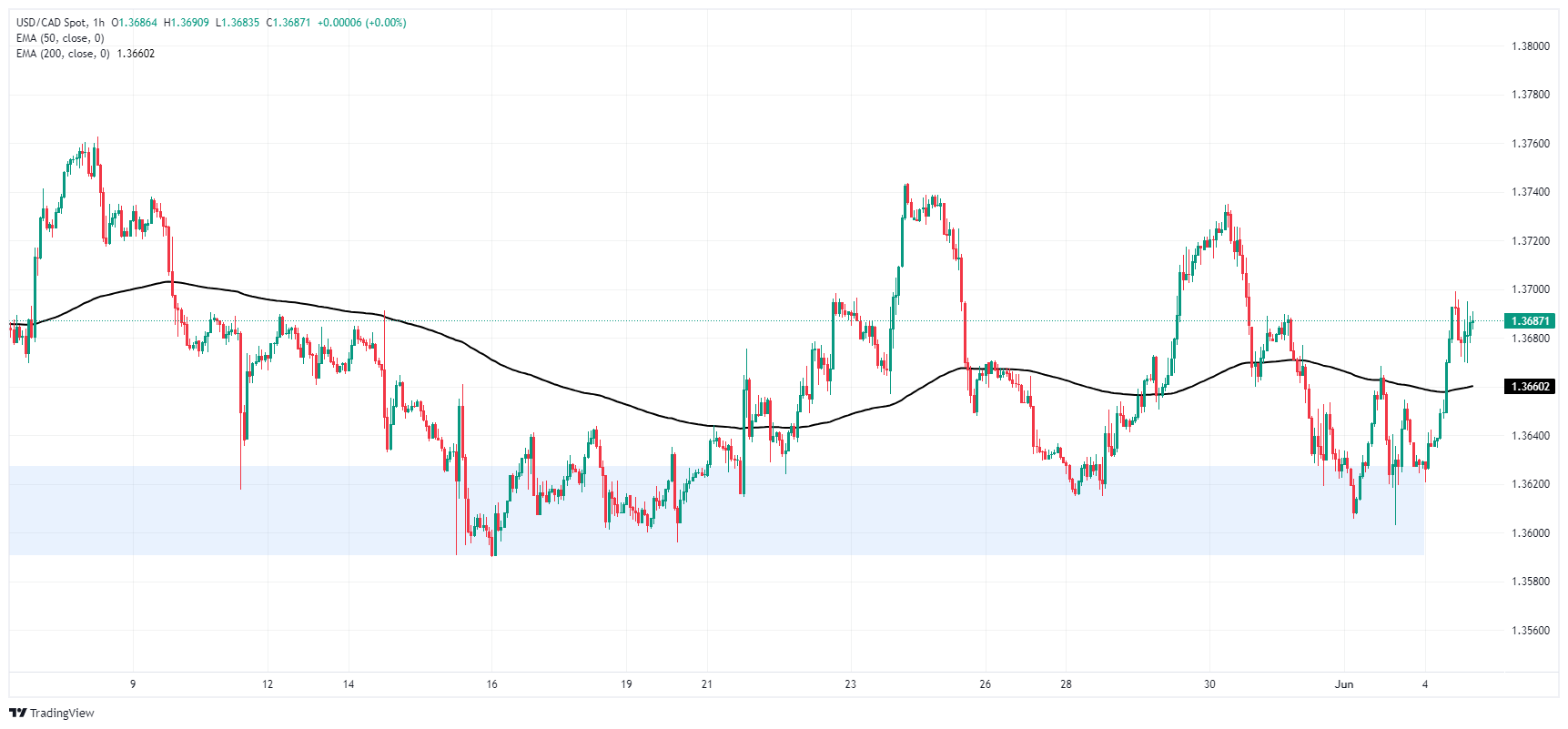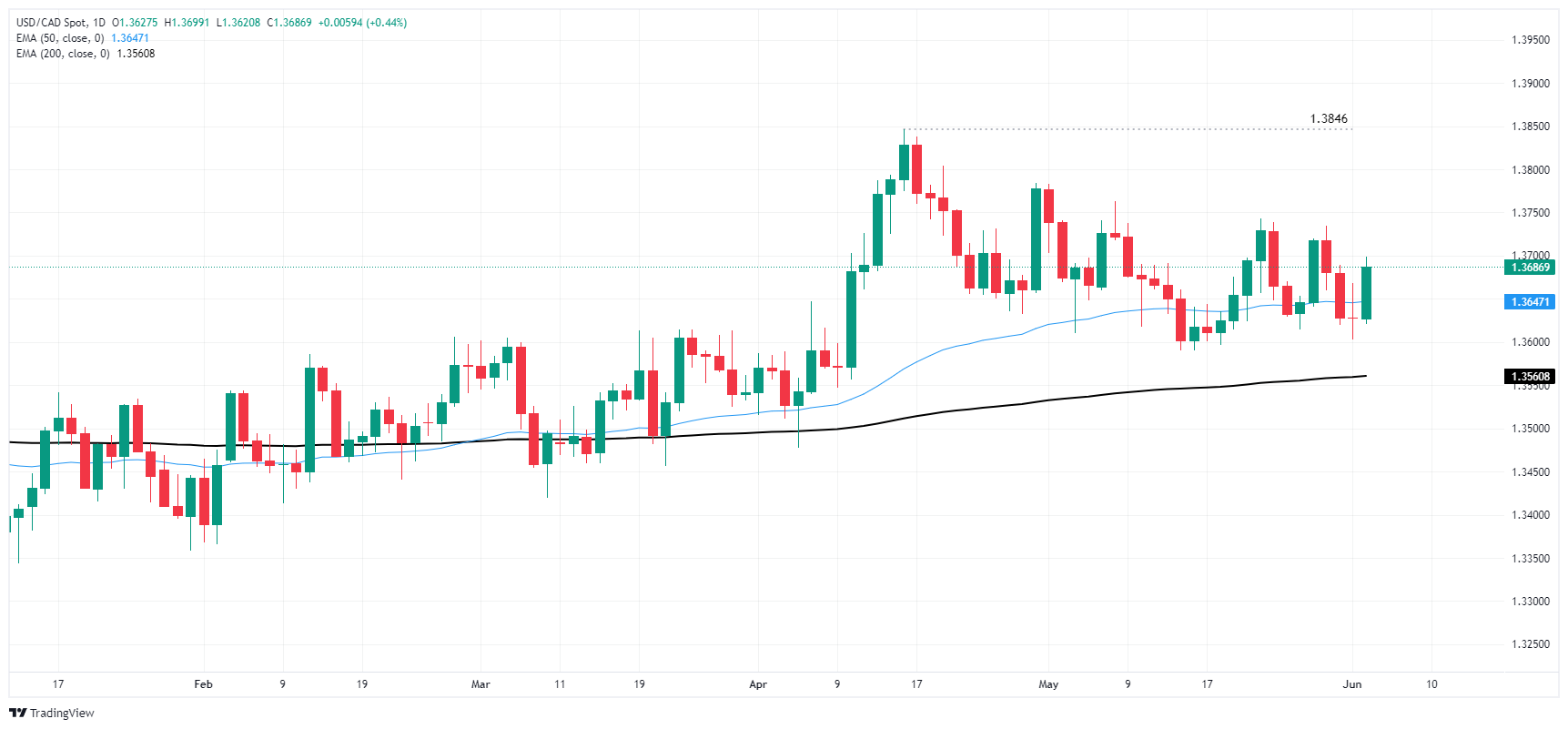- Analytics
- News and Tools
- Market News
- Canadian Dollar softens stance on data-light Tuesday
Canadian Dollar softens stance on data-light Tuesday
- Canadian Dollar backslides 0.4% against Greenback after mixed US data.
- Canada delivers BoC’s latest rate call on Wednesday.
- Broader markets pivot to Wednesday’s ADP jobs data, Friday’s NFP.
The Canadian Dollar (CAD) broadly fell on Tuesday, further erasing recent gains against the US Dollar (USD). 1.3600 is proving too tough of a nut for USD/CAD sellers to crack, and the pair remains mired in technical congestion since falling from the year’s highs near 1.3840 in mid-April.
Canada is absent from the economic data docket on Tuesday, leaving the Canadian Dollar at the mercy of broad market sentiment. Mixed US data, combined with an extended backslide in Crude Oil prices, has left investors with one foot planted firmly in safe havens and eroded near-term buying strength in the CAD. The Bank of Canada (BoC) is broadly expected to deliver its first quarter-point interest rate cut on Wednesday, nearly a year after the Canadian central bank raised rates to a 23-year-high of 5.0% last July.
Daily digest market movers: US data drives markets after mixed data and steepening revisions
- US Factory Orders in April rose 0.7% MoM, better than the forecast of 0.6%, but March’s figures saw a steep downside revision to 0.7% from the initial print of 1.6%.
- US JOLTS Job Openings in April also slipped back, falling to 8.059 million versus the forecast of 8.34 million. The previous month’s initial print was also revised to 8.355 million from 8.488 million.
- The BoC is expected to cut interest rates by 25 basis points on Wednesday, bringing Canada’s main policy rate down to 4.75% from 5.0%. The BoC will also deliver its latest Monetary Policy Statement.
- US ADP Employment Change figures due Wednesday to serve as a volatile preview of Friday’s US Nonfarm Payrolls.
- US ADP Employment Change for May is expected to slip back to 173K from 192K, while Friday’s NFP is expected to show the US added 190K jobs in May compared to the previous 175K.
Canadian Dollar PRICE Today
The table below shows the percentage change of Canadian Dollar (CAD) against listed major currencies today. Canadian Dollar was the weakest against the Japanese Yen.
| USD | EUR | GBP | JPY | CAD | AUD | NZD | CHF | |
|---|---|---|---|---|---|---|---|---|
| USD | 0.20% | 0.15% | -0.84% | 0.43% | 0.70% | 0.28% | -0.75% | |
| EUR | -0.20% | -0.05% | -1.03% | 0.25% | 0.49% | 0.09% | -0.95% | |
| GBP | -0.15% | 0.05% | -0.97% | 0.30% | 0.55% | 0.16% | -0.87% | |
| JPY | 0.84% | 1.03% | 0.97% | 1.29% | 1.54% | 1.11% | 0.11% | |
| CAD | -0.43% | -0.25% | -0.30% | -1.29% | 0.26% | -0.15% | -1.16% | |
| AUD | -0.70% | -0.49% | -0.55% | -1.54% | -0.26% | -0.41% | -1.41% | |
| NZD | -0.28% | -0.09% | -0.16% | -1.11% | 0.15% | 0.41% | -1.00% | |
| CHF | 0.75% | 0.95% | 0.87% | -0.11% | 1.16% | 1.41% | 1.00% |
The heat map shows percentage changes of major currencies against each other. The base currency is picked from the left column, while the quote currency is picked from the top row. For example, if you pick the Canadian Dollar from the left column and move along the horizontal line to the US Dollar, the percentage change displayed in the box will represent CAD (base)/USD (quote).
Technical analysis: USD/CAD poised for another spin around midrange
The Canadian Dollar (CAD) is broadly lower on Tuesday, losing ground against the majority of its major currency peers. The CAD is steeply lower against the Japanese Yen (JPY), falling -1.25% against the day’s best-performing currency, and has shed nearly -1.10% against the Swiss Franc (CHF). The CAD still managed to find higher ground against the Australian Dollar (AUD), gaining a third of a percent against the Aussie.
USD/CAD has bounced back from another dip toward 1.3600, climbing into the 1.3700 handle after the Canadian Dollar shed over four-tenths of a percent against the Greenback. The pair is caught in sideways churn, and a near-term demand zone just above 1.3600 is keeping bids bolstered as the CAD struggles to find buyers.
With the BoC set to widen the interest rate differential between the CAD and the USD on Wednesday, investors will be keeping an eye on any spikes that could kick off a leg higher and send the USD/CAD back into 2024’s peaks at 1.3846. On the low side, long-term technical support sits at the 200-day Exponential Moving Average (EMA) at 1.3560.
USD/CAD hourly chart
USD/CAD daily chart
Canadian Dollar FAQs
The key factors driving the Canadian Dollar (CAD) are the level of interest rates set by the Bank of Canada (BoC), the price of Oil, Canada’s largest export, the health of its economy, inflation and the Trade Balance, which is the difference between the value of Canada’s exports versus its imports. Other factors include market sentiment – whether investors are taking on more risky assets (risk-on) or seeking safe-havens (risk-off) – with risk-on being CAD-positive. As its largest trading partner, the health of the US economy is also a key factor influencing the Canadian Dollar.
The Bank of Canada (BoC) has a significant influence on the Canadian Dollar by setting the level of interest rates that banks can lend to one another. This influences the level of interest rates for everyone. The main goal of the BoC is to maintain inflation at 1-3% by adjusting interest rates up or down. Relatively higher interest rates tend to be positive for the CAD. The Bank of Canada can also use quantitative easing and tightening to influence credit conditions, with the former CAD-negative and the latter CAD-positive.
The price of Oil is a key factor impacting the value of the Canadian Dollar. Petroleum is Canada’s biggest export, so Oil price tends to have an immediate impact on the CAD value. Generally, if Oil price rises CAD also goes up, as aggregate demand for the currency increases. The opposite is the case if the price of Oil falls. Higher Oil prices also tend to result in a greater likelihood of a positive Trade Balance, which is also supportive of the CAD.
While inflation had always traditionally been thought of as a negative factor for a currency since it lowers the value of money, the opposite has actually been the case in modern times with the relaxation of cross-border capital controls. Higher inflation tends to lead central banks to put up interest rates which attracts more capital inflows from global investors seeking a lucrative place to keep their money. This increases demand for the local currency, which in Canada’s case is the Canadian Dollar.
Macroeconomic data releases gauge the health of the economy and can have an impact on the Canadian Dollar. Indicators such as GDP, Manufacturing and Services PMIs, employment, and consumer sentiment surveys can all influence the direction of the CAD. A strong economy is good for the Canadian Dollar. Not only does it attract more foreign investment but it may encourage the Bank of Canada to put up interest rates, leading to a stronger currency. If economic data is weak, however, the CAD is likely to fall.
© 2000-2024. All rights reserved.
This site is managed by Teletrade D.J. LLC 2351 LLC 2022 (Euro House, Richmond Hill Road, Kingstown, VC0100, St. Vincent and the Grenadines).
The information on this website is for informational purposes only and does not constitute any investment advice.
The company does not serve or provide services to customers who are residents of the US, Canada, Iran, The Democratic People's Republic of Korea, Yemen and FATF blacklisted countries.
Making transactions on financial markets with marginal financial instruments opens up wide possibilities and allows investors who are willing to take risks to earn high profits, carrying a potentially high risk of losses at the same time. Therefore you should responsibly approach the issue of choosing the appropriate investment strategy, taking the available resources into account, before starting trading.
Use of the information: full or partial use of materials from this website must always be referenced to TeleTrade as the source of information. Use of the materials on the Internet must be accompanied by a hyperlink to teletrade.org. Automatic import of materials and information from this website is prohibited.
Please contact our PR department if you have any questions or need assistance at pr@teletrade.global.















